Fort Wayne, Indiana, Hgh State Clinic, Hgh Injections, Hrt Doctors
Fort Wayne, Indiana Blood Testing Facilities
 Represents a LabCorp blood testing facility
Represents a LabCorp blood testing facility Represents a Quest Diagnostics blood testing facility
Represents a Quest Diagnostics blood testing facility

Nearby Labcorp Blood Testing facilities:
- Labcorp Center Distance: 2 m, 3217 Lake Ave, Fort Wayne, Allen County, IN, 46805
- Labcorp Center Distance: 3 m, 6033 N. Clinton St, Fort Wayne, Allen County, IN, 46825
- Labcorp Center Distance: 6 m, 10020 Dupont Circle, Fort Wayne, Allen County, IN, 46825
- Labcorp Center Distance: 21 m, 955 High St, Decatur, Adams County, IN, 46733
- Labcorp Center Distance: 41 m, 3250 Intertech Dr Ste C, Angola, Steuben County, IN, 46703
- Labcorp Center Distance: 44 m, 1127 N Western Ave, Marion, Grant County, IN, 46952
- Labcorp Center Distance: 58 m, 855 W Market St, Lima, Allen County, OH, 45805
- Labcorp Center Distance: 59 m, 1012 Bellefontaine Ave, Lima, Allen County, OH, 45801
- Labcorp Center Distance: 63 m, 800 S Tillotson, Muncie, Delaware County, IN, 47304
- Labcorp Center Distance: 68 m, 3515 N Main St. Ste 2, Mishawaka, St Joseph County, IN, 46545
- Labcorp Center Distance: 72 m, 1825 E 18Th St, Anderson, Madison County, IN, 46016
- Labcorp Center Distance: 73 m, 1000 S Main St, Tipton, Tipton County, IN, 46072
- Labcorp Center Distance: 79 m, 1007 N 16Th St, New Castle, Henry County, IN, 47362
- Labcorp Center Distance: 81 m, 2200 Forest Ridge Pkwy Ste 310, New Castle, Henry County, IN, 47362
- Labcorp Center Distance: 86 m, 1565 S Byrne Rd Ste 105, Toledo, Lucas County, OH, 43614
- Labcorp Center Distance: 92 m, 277 E Carmel Dr, Carmel, Hamilton County, IN, 46032
- Labcorp Center Distance: 94 m, 7914 N Shadeland Suite 150, Indianapolis, Marion County, IN, 46250
- Labcorp Center Distance: 97 m, 2020 West 86Th Street Ste 106, Indianapolis, Marion County, IN, 46260
- Labcorp Center Distance: 98 m, 2605 N Lebanon St, Lebanon, Boone County, IN, 46052
Nearby Quest Blood Testing facilities:
- Quest Center Distance: 2 m, 3030 Lake Ave, Fort Wayne, Allen County, IN, 46805-5428
- Quest Center Distance: 6 m, 7972 W Jefferson Blvd, Fort Wayne, Allen County, IN, 46804-4140
- Quest Center Distance: 41 m, 201 E. High St, Bryan, Williams County, OH, 43506-0000
- Quest Center Distance: 70 m, 16597 State Road 23, South Bend, St Joseph County, IN, 46635-1461
- Quest Center Distance: 84 m, 816 Dillon Drive, Richmond, Wayne County, IN, 47374-1911
- Quest Center Distance: 87 m, 9669 146Th Street, Noblesville, Hamilton County, IN, 46060-5005
- Quest Center Distance: 88 m, 3950 Sunforest Ct, Toledo, Lucas County, OH, 43623-4485
- Quest Center Distance: 93 m, 8435 Clearvista Pl, Indianapolis, Marion County, IN, 46256-3741
- Quest Center Distance: 95 m, 5 W Wenger Rd, Englewood, Montgomery County, OH, 45322-2723
- Quest Center Distance: 96 m, 900 S. Dixie Drive, Vandalia, Montgomery County, OH, 45377-2657
- Quest Center Distance: 97 m, 2500 Niles Rd, Saint Joseph, Berrien County, MI, 49085-3272
- Quest Center Distance: 98 m, 8071 Township Line Rd, Indianapolis, Marion County, IN, 46260-2601
Fort Wayne Hormone Replacement Therapy Services
Hormone Restoration and Optimization represent a new and exciting change in 21st Century Health and Wellness treatment. The Conscious Evolution Institute is a licensed and board certified medical HRT Clinic which specializes in treating patients thirty years of age and older suffering from deteriorating health directly resulting from Hormone Imbalance. Our clinic is nationwide, with associates located all throughout the Fort Wayne, Indiana area, as well as distributed throughout the state. We can arrange for an appointment with a Hormone Doctor in your area that can provide the preliminary assessment necessary to find out if you can benefit from the HRT Treatment Options that we provide.
Our friendly Hormone Physicians and Specialists are just a phone call away, and we look forward to helping you take greater control of your life and your health for your own benefit and for the benefit of the ones that you love.
Fort Wayne Testosterone Treatments for Andropause and Low-T
Testosterone is the hormone that makes a man a man, and when Testosterone Levels fall into decline, it leads to symptoms that rob a man of his manhood, including erectile dysfunction, loss of libido, depression, anxiety, loss of strength and energy, and weight gain. It even leads to health issues like diabetes and hypertension which can seriously hinder the health of the cardiovascular system and significantly increase mortality risk. Testosterone Replacement with Creams, Gels, and Patches can restore your sexual potency and improve your overall health and wellness. We have HRT Doctors in the Fort Wayne Area that can help you see if you qualify for Testosterone.
Fort Wayne Bio-Identical HGH Clinic for Growth Hormone Deficiency
HGH Deficiency is a condition which can severely negatively impact both men and women as they grow older. Growth Hormone is the body's primary metabolic regulator, and helps systems all throughout the body function at optimal performance. Growth Hormone Deficiency can lead to physiological changes which rapidly deplete the health of the body, including weight gain, fatigue, loss of muscle mass, cognitive decline, depression, poor cholesterol levels, and foggy memory just to mention a few. HGH Injection Therapy can cancel out the effects of Growth Hormone Decline, helping you live a healthier life. If you are interested in Fort Wayne Human Growth Hormone Therapy, give us a call!
Fort Wayne Sermorelin Injections for HGH Deficiency and Hormone Imbalance
Human Growth Hormone is a highly effective medical treatment for those that suffer from Age-Related Growth Hormone Deficiency, but HRT Physicians and their patients are turning to Sermorelin Acetate with greater frequency evey year. Sermorelin helps the body make more of its own Human Growth Hormone by imitating the function of GH-RH, the direct precursor of endogenous Human Growth Hormone. In fact, Sermorelin and GH-RH are functionally identical, meaning that they are similar enough to have the exact same effect on the body! Sermorelin is cheaper than Bio-Identical HGH and produces more natural patterns of release. If you are interested in buying Sermorelin in Fort Wayne, we can help you get Sermorelin for Growth Hormone Deficiency.
Fort Wayne HCG Weight Loss Injections
The Conscious Evolution Institute also offers Hormone Therapy Regimens specifically designed to help patients lose weight in a Physician-Monitored way with Bio-Identical Hormones, including HCG. Bio-Identical HCG Therapy has helped patients across the nation lose weight to the tune of thirty pounds per month, and allowing them to do so without being consumed by fatigue or hunger. HCG, when used in conjunction with Caloric Restriction, can burn body fat at a rapid pace while promoting a healthy body composition. If you are looking for a Fort Wayne HRT Diet Plan, look no further!
Fort Wayne, Indiana Information
Fort Wayne is located in Northeast Indiana, a couple of hours away from Indianapolis in the heart of the state. Fort Wayne goes by a number of nicknames, including The City that Saved Itself and The Summit City. There are a number of institutes of higher learning in Fort Wayne, including the University of Saint Francis, the Indiana Institute of Technology, and Purdue University-Fort Wayne. Fort Wayne originally was a city that revolved around automotive manufacture, but today has grown significantly in diversity, especially in the areas of banking, leisure, healthcare, logistics, and distribution. Suburbs of Fort Wayne include New Haven, Hoagland, Yoder, Roanoke, and Arcola.
All About Fort Wayne, Indiana Geographic Area
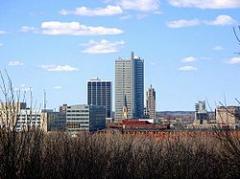
Fort Wayne is a city in the U.S. state of Indiana and the county seat of Allen County. The population was 255,824 as of the July 1, 2011 Census estimate making it the 74th largest city in the United States and the second-largest in Indiana after Indianapolis. The municipality is located in northeastern Indiana, approximately 18 miles (29 km) west of the Ohio border and 50 miles (80 km) south of the Michigan border.
Fort Wayne is the principal city of the Fort Wayne metropolitan area, which for statistical purposes is defined as Allen, Wells, and Whitley counties, for an estimated population of 419,453, In addition to those three core counties, the combined statistical area, defined as including Adams, DeKalb, Huntington, and Noble counties, has a population of about 615,077.
Under the direction of American Revolutionary War statesman General "Mad" Anthony Wayne, the United States Army built Fort Wayne last in a series of forts near the Miami Indian village of Kekionga in 1794. Named in Wayne's honor, Fort Wayne established itself at the confluence of the St. Joseph River, St. Marys River, and Maumee River as a trading post for European settlers. The village was platted in 1823 and experienced tremendous growth after completion of the Wabash and Erie Canal.
By the 21st century, Fort Wayne's economy was based on manufacturing, education, insurance, health care (particularly medical devices), transportation and distribution, and defense. The city has been an All-America City Award recipient in 1982, 1998, and 2009.
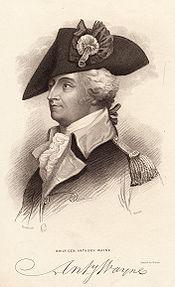
The Miami nation first established a settlement at the Maumee, St. Joseph, and St. Marys Rivers in the mid-17th century called Kekiongah. The village was the traditional capital of the Miami nation and related Algonquian tribes. Historians believe that around 1676, French priests and missionaries visited the Miami on their way back from a mission at Lake Michigan. In 1680, Rene-Robert Cavelier, Sieur de La Salle sent a letter to the Governor of New France, Louis de Buade de Frontenac stating he had also stopped there. In the 1680s, French traders established a post at the location because it was the crucial portage between the Great Lakes and the Mississippi River. The Maumee River is approximately ten miles (16 kilometers) away from the Little River branch of the Wabash River, which flows, in turn, into the Ohio River.
In 1696, Comte de Frontenac appointed Jean Baptiste Bissot, Sieur de Vincennes as commander of the French outpost in Miami country. The French built the first fort on the site, Fort Miamis, in 1697 as part of a group of forts built between Quebec, Canada, and St. Louis. In 1721, a few years after Bissot's death, Fort Miamis was replaced by Fort St. Philippe des Miamis. The first census, performed in 1744 on the order by the governor of Louisiana, revealed a population of approximately forty Frenchmen and one thousand Miami. Increasing tension between France and the United Kingdom developed over the territory. In 1760, after defeat by British forces in the French and Indian War, the area was ceded to the British Empire. The fort was again renamed, this time to Fort Miami. In 1763, various Native American nations rebelled against British rule and retook the fort as part of Pontiac's Rebellion. The Miami regained control of Kekionga, a rule that lasted for more than thirty years.
In 1790, President George Washington ordered the United States Army to secure Indiana. Three battles were fought in Kekionga against Little Turtle and the Miami Confederacy. Miami warriors annihilated the United States Army in the first two battles. Anthony Wayne led a third expedition, destroying the village while its warriors were away. When the tribe returned to their destroyed village, Little Turtle decided to negotiate peace. After General Wayne refused it, the tribe was advanced to Fallen Timbers where they were defeated on August 20, 1794. On October 22, 1794, the United States army captured the Wabash-Erie portage from the Miami Confederacy and built a new fort at the three rivers, Fort Wayne, in honor of General Wayne.
Initially a mere frontier outpost, the town was incorporated in 1829 with a population of 300. The arrival of the Wabash and Erie Canal opened passages to the Great Lakes and Mississippi River, bringing the population to 2,080 when the town was incorporated as the City of Fort Wayne on February 22, 1840. Fort Wayne's Summit City nickname came from the fact that the city was situated at the highest point, or summit, along the canal route. Shortly after the opening of the canal, several rail lines soon ran through the city, strengthening transportation in the region and allowing industry to flourish. By the 1870s, rail had become the preferred method of transportation, and the Wabash and Erie Canal faded to the wayside.
Population growth occurred most in the 19th century, with the arrival of a large number of Germans, Irish, and later Poles. Most immigrants were of Catholic or Lutheran faith. Fort Wayne was a hub for recruitment and training during the American Civil War, with new soldiers from nearby counties assembling here before deployment to the battlefields.
The Germans and Irish usually gave strong majorities for the Democrats; Fort Wayne was the only Northern city of 50,000 or more carried by Democrat William Jennings Bryan in 1896.
Many German Americans resisted the Prohibition and women's suffrage movements that gained strength elsewhere during the Progressive Era.
At the turn of the 20th century, Fort Wayne's economy was based substantially on manufacturing. After 1910, many businesses began manufacturing parts to the automobile industry exploding in nearby Detroit. The Wayne Knitting Mills opened in 1891 to produce the nation's first full-fashioned hosiery. In 1885, Sylvanus F. Bowser introduced self-measuring oil tanks for kerosene; by the 1930s, three Fort Wayne factories made 70 percent of the nation's gasoline pumps. Other factories made railroad car wheels, boilers, tanks, washing machines, medicines, motor trucks, automatic phonographs, display cases, meat-packing products, mining machinery, tents and awnings, and beer. With 10,000 employees, General Electric was the city's largest employer during this period. General Electric's Industrial Motor Division has been headquartered in Fort Wayne since the companies acquisition of the Fort Wayne Electric Works in 1911. GE has manufactured many different products in Fort Wayne including watt-hour meters, fractional horsepower motors, and transformers.
Over 6,000 women and girls worked in factories from 1900 to 1920, chiefly in traditionally female industries such as food preparation and hosiery. Employers, such as Wayne Knitting Mills and General Electric, built well-appointed dormitories and clubhouses to attract workers. In the 1920s prosperity led to improved conditions, including shorter hours and higher wages.
However, like all cities dependent on heavy industry, Fort Wayne was badly hit by the Great Depression beginning in 1929, with most factories cutting their workforce. When local relief moneys ran out, Fort Wayne turned to the New Deal for help, as the CCC, FERA, WPA, and PWA poured money in, and the AAA helped regional farmers. Several programs helped homeowners pay their mortgages. By summer 1938, as the economy skidded downward again, one in six families in Allen County were on welfare, with 2/3 of the funding coming from the WPA. The Germans had turned hostile to the Democrats in World War I, but the city voted for Roosevelt.
The city provided numerous recreational activities, especially after the Federal WPA began construction projects in 1935. In 1940 the city provided 25 parks totaling 865 acres (350 ha), with 39 horseshoe courts, 67 tennis courts, 27 softball and hardball diamonds, 6 football fields, 2 archery courts, 2 pools, 3 bridle paths, and 12 supervised playgrounds, as well as a municipal golf course that charged 60 cents a round. The city also operated a bathing beach on the St. Joseph River. Downtown included 15 movie theaters, all with one screen and double features; the largest was the Embassy Theatre with 2,500 seats.
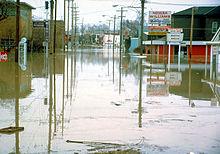
The Great Flood of 1913 left six dead and 15,000 homeless; the governor declared martial law until order could be restored and relief services opened.
The costliest disaster in Fort Wayne's history, the Great Flood of 1982, exceeded $56 million in damages and prompted a visit from President Ronald Reagan. In the days following the flood, 9,000 residents were forced to evacuate and over 2,000 residences and businesses were damaged by floodwaters. One brigade of sandbaggers is credited with saving 1,860 homes in the Lakeside neighborhood as clay dikes along the Maumee River began showing signs of failure. The efforts by thousands of volunteers earned Fort Wayne the distinction of The City That Saved Itself. Since this flood, miles of levees and dikes were built or enhanced, the U.S. Army Corps of Engineers widened the Maumee River, and Headwaters Park was established near the confluence of the rivers in downtown Fort Wayne, all implemented to alleviate future flooding.
In the 2000s, much of the city's focus has been reinvesting and beautifying the urban core of Fort Wayne. Within the last decade, the city has improved in this venture, with the renovations and expansions of the Allen County Public Library and Grand Wayne Convention Center, as well as the addition of Headwaters Park. In 2006, the $130 million Harrison Square development was announced, containing a new baseball stadium, parking garage, condominiums, shops, and hotel in downtown Fort Wayne. The baseball stadium, Parkview Field, opened in April 2009 and the hotel, a Courtyard by Marriott, opened in September 2010. In 2011, private developers announced plans to convert the long-underused Anthony Wayne Building into about 50 high-end condominiums with street-level shops at a cost of $15 million.
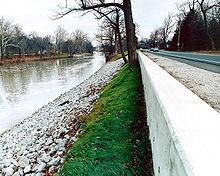
According to the 2010 census, the city has a total area of 110.83 square miles (287.0 km2), of which 110.62 square miles (286.5 km2) (or 99.81%) is land and 0.21 square miles (0.54 km2) (or 0.19%) is water.
Fort Wayne is located at 41 °04 a²50 a³N 85 °08 a²21 a³W / 41.08056 °N 85.13917 °W / 41.08056; -85.13917 (41.07253, na85.13937). For a regional summit, Fort Wayne lies on fairly flat land, with the exception of few hills and depressions throughout the region. Marshes and wetlands are prevalent in portions of southwest Fort Wayne and Allen County, as well as some quarries. West of the city lies the Tipton Till Plain while land east of the plain is the former Black Swamp. The St. Marys River cuts through the southeast section of Allen County, flowing northward, while the St. Joseph River cuts through the northeast section of the county, flowing southward. Both rivers converge roughly in the center of the county to form the Maumee River, which flow northeastward, eventually emptying into Lake Erie.
The city lies along the St. Lawrence River Continental Divide which separates the Great Lakes Basin from the rest of the Atlantic Ocean watershed.
According to the Koppen climate classification, Fort Wayne lies in the humid continental climate zone (Dfa), experiencing four distinct seasons. Typically, summers are hot and humid, and winters are generally cold with moderate snowfall. Precipitation is fairly evenly distributed throughout the year.
The National Weather Service reports the highest recorded temperature in the city at 106 °F (41 °C), most recently on June 28, 2012, and the lowest recorded temperature at na24 °F ( na31 °C) on January 12, 1918. The wettest month on record was July 1986, with 11.00 inches (279 mm) of precipitation recorded. The greatest 24-hour rainfall was 4.93 in (125 mm) on August 1, 1926. The average annual precipitation is 37.9 in (960 mm), recorded at Fort Wayne International. During the winter season, snowfall accumulation averages 32.9 in (84 cm) per year. Lake effect snow is not rare to the region, but usually appears in the form of light snow flurries. The snowiest month on record was 29.5 in (75 cm) in January 1982. The greatest 24-hour snowfall was 13.6 in (35 cm) on March 10, 1964.
Severe weather is not uncommon, particularly in the spring and summer months. The most severe tornado, an EF2, struck portions of northern Fort Wayne on May 26, 2001, causing extensive damage to businesses along the Coliseum Boulevard corridor and a subdivision, but resulting in only three minor injuries. The city was paralyzed in the days following the Great Blizzard of 1978, with snow accumulations in upwards of 24 in (61 cm) and drifts at 20 feet (6.1 m) in some places, driven by 55 mile-per-hour wind gusts.
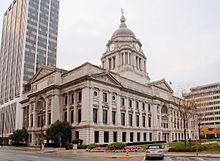
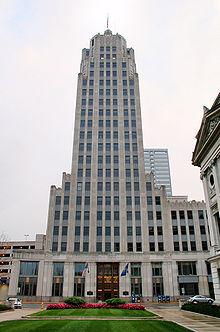
Fort Wayne has a mayor-council government. Common Council has nine elected members, one representative from each of the city's six council districts and three at-large members, serving four-year terms. The district members represent the constituents living within the boundaries of their jurisdiction, while the at-large members represent the citizens as a whole.
Democrat Tom Henry has been Fort Wayne's mayor since 2008. Elizabeth Malloy was appointed to the position of Deputy Mayor in 2010. Sandra Kennedy has held the city clerk position since 1983.
Under the Unigov provision of Indiana Law, City-County consolidation would have been automatic when Fort Wayne's population exceeded 250,000 and became a first class city in Indiana. Fort Wayne nearly met the state requirements for first class city designation on January 1, 2006 when 12.8 square miles (33 km2) of neighboring Aboite Township (and a small section of Wayne Township) including 25,094 people were annexed. However, a 2004 legislative change raised the population requirements from 250,000 to 600,000, which ensured Indianapolis' status as the only first class city in Indiana.
Municipal and State laws are enforced by the Fort Wayne Police Department, an organization of 460 officers. In 2006, Fort Wayne's crime rate was 5104.1 per 100,000 people, slightly above the national average of 4479.3. There were 18 murders, 404 robberies, and 2,128 burglaries in 2006.
Fort Wayne has four sister cities as designated by Sister Cities International:
The first census was performed in 1744 on the order by the governor of Louisiana, revealed a population of approximately forty Frenchmen and one thousand Miami.
According to the 2010 Census, there were 253,691 people and 113,541 households. The racial makeup of the city is 73.62% White, 15.41% Black or African American, 0.37% Native American, 3.3% Asian (1.4% Burmese, 0.4% Indian, 0.3% Vietnamese, 0.2% Chinese, 0.2% Filipino, 0.1% Korean, 0.1% Laotian, 0.1% Thai), 0.06% Pacific Islander, 3.72% from other races, and 3.52% from two or more races. 7.96% of the population are Hispanic or Latino of any race. Among the Hispanic population, 6.1% are Mexican, 0.4% Puerto Rican, and 0.3% Guatemalan. Non-Hispanic Whites were 70.3% of the population in 2010, down from 87.7% in 1970.
According to the census of 2000, there were 90,915 housing units at an average density of 1,151.5 per square mile (444.6/km ²). There were 83,333 households out of which 31.5% had children under the age of 18 living with them, 41.9% were married couples living together, 14.6% had a female householder with no husband present, and 39.2% were non-families. 32.6% of all households were made up of individuals and 10.3% had someone living alone who was 65 years of age or older. The average household size was 2.41 and the average family size was 3.08.
In the city the population is spread out with 27.0% under the age of 18, 10.7% from 18 to 24, 30.2% from 25 to 44, 19.7% from 45 to 64, and 12.5% who are 65 years of age or older. The median age is 33 years of age. For every 100 females there are 94.0 males. For every 100 females age 18 and over, there are 90.4 males.
The median income for a household in the city is $36,518, and the median income for a family is $45,040. Males have a median income of $34,704 versus $25,062 for females. The per capita income for the city is $18,517. 12.5% of the population and 9.6% of families are below the poverty line. Out of the total population, 17.5% of those under the age of 18 and 7.6% of those 65 and older are living below the poverty line.
Fort Wayne is cited as having the highest Burmese American population in the United States, with estimates near 6,000.
Besides its Summit City nickname, Fort Wayne is also informally referred to as the City of Churches, a nickname that stretches back to the late-19th century when the city was the hub of regional Catholic, Lutheran, and Episcopal faiths.
The Missouri Synod of the Lutheran Church was constituted in Saint Paul's Evangelical Lutheran Church, then known as Saint Pauls Evangelisch-Lutheranische Gemeinde, once founded in 1837 as Fort Wayne's first Lutheran church. The Episcopal Church moved into Fort Wayne in 1839, attracting settlers from New England and New York, along with English, Irish, and Canadian immigrants. Fort Wayne is the principal city of the Catholic Diocese of Fort Wayne-South Bend which covers northeastern and north central Indiana. The principal cathedral of the diocese is the Cathedral of the Immaculate Conception.
As of May 2008, four national Christian denominations were headquartered in Fort Wayne: the American Association of Lutheran Churches, Fundamental Baptist Fellowship Association, Missionary Church, Inc., and the Fellowship of Evangelical Churches. Fort Wayne's Jewish population is served by Congregation Achduth Vesholom, the oldest Jewish congregation in Indiana, founded in 1848. In addition, Congregation B'nai Jacob serves the region's Conservative Jewish population. Both congregations participate in the Fort Wayne Jewish Federation. There is also an increasing religious minority found among Fort Wayne's immigrant communities, which include Hinduism, Islam, and Buddhism.
A major manufacturing center in the Midwest by the 20th century, Fort Wayne included such employers as General Electric, Magnavox, Westinghouse, and International Harvester. Also vital employers, Phelps Dodge, Rea Magnet Wire, and Essex Wire comprised the largest concentration of copper wire production globally during World War II. As the century came to close, advancements in technology and the reduction of manufacturing jobs nationally led Fort Wayne to be counted among other cities in the Rust Belt.
However, the city's economy has diversified with time to include education, insurance, health care, and defense and security. The service and hospitality sector has also grown recently, with 5.4 million tourists spending more than $415 million in Fort Wayne in 2006. In 2009, Forbes ranked the Fort Wayne metropolitan area 67th on its list of 200 metropolitan areas in its annual "Best Places For Business And Careers" report. Individually, the city was ranked 5th in cost of living and 12th in cost of doing business.
Fort Wayne is headquarters for such companies as Do It Best, Genteq, Indiana Michigan Power, Medical Protective, North American Van Lines, Rea Magnet Wire, Steel Dynamics, Sweetwater Sound, and Vera Bradley. Steel Dynamics is the only Fortune 500 company headquartered in the city, ranking 318th.
Fort Wayne's ten largest non-government employers:
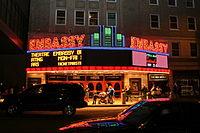
The John and Ruth Rhinehart Music Center opened in 2007 on the Indiana University-Purdue University Fort Wayne campus to hold community concerts and university events. The 85,000-square-foot (7,900 m2) auditorium includes 1,600 seats. The University of Saint Francis Performing Arts Center contains a 2,086-seat auditorium and a 15,000-square-foot (1,400 m2) Valencia Ballroom. Foellinger Outdoor Theatre, in Franke Park near the zoo, offers seasonal acts and movies during warmer months.
Located in downtown's burgeoning Cultural District, Arts United Center, located adjacent to the Fort Wayne Museum of Art, houses the Fort Wayne Civic Theater, Fort Wayne Dance Collective, and Fort Wayne Youtheatre, with seating for 660. Hall Community Arts Center anchors the east side of the district, housing Cinema Center, which features independent, foreign, classic, and documentary films.
The Embassy Theatre is a 2,471-seat performing arts theater originally built in 1928 as a movie palace. The Embassy presents shows ranging from concert tours, Broadway musicals, dance, community events, and lectures, serving over 200,000 patrons annually. The Embassy often plays host to the Fort Wayne Philharmonic Orchestra. The Grand Wayne Center, though used mainly for exhibitions and conventions, also plays host to dance or choir productions, such as the annual FAME Festival (The Foundation for Art and Music in Elementary Education), which showcases local school choirs and dancers.
In 2010, the Voices of Unity choir traveled to Shaoxing, China to participate in the 2010 World Choir Games. Directed by Marshall White, the choir won two gold medals, including the overall champions in the Gospel and Spiritual category.

The African/African aeAmerican Historical Museum, which opened near downtown in 2000, contains two floors and ten exhibits relating to slavery in the United States, the Underground Railroad, African aeAmerican inventors, and the history of the local African aeAmerican community. The Greater Fort Wayne Aviation Museum at Fort Wayne International Airport highlights aviation history in the region and displays memorabilia relating to historical aviation figures, such as Fort Wayne's own Art Smith and World War I Ace Paul Baer.
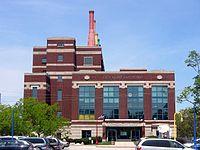
Established in 1921, the Fort Wayne Museum of Art (FWMoA) is accredited by the American Association of Museums, specializing in exhibiting and collecting works of American art. Located just south of the FWMoA, the Auer Center for Arts and Culture was dedicated in 2011 to house local arts and cultural organizations, including Artlink and Fort Wayne Ballet. The History Center, located in Fort Wayne's Old City Hall, manages a collection of more than 23,000 artifacts recalling the region's history. The center is overseen by the Allen County aeFort Wayne Historical Society, which also maintains the Chief Jean Baptiste de Richardville House, one of two National Historic Landmarks in the city.
Located at downtown's Engine House 3, the Fort Wayne Firefighters Museum exhibits artifacts from the Fort Wayne Fire Department dating back to 1839 as well as showcasing four early previously-used fire engines. The Harold W. McMillen Center for Health Education utilizes interactive programs and displays to educate youth to make decisions that promote physical, emotional, and social well-being. Opened in 1995, Science Central is an interactive science museum geared toward children. Located in Lawton Park just north of downtown Fort Wayne, the center contains permanent displays as well as temporary exhibitions.
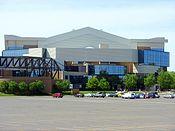

Fort Wayne is currently home to four minor league sports franchises. These include Fort Wayne Fever of soccer's Premier Development League, Fort Wayne Komets of the East Coast Hockey League, Fort Wayne Mad Ants of the NBA Development League, and Fort Wayne TinCaps of baseball's Midwest League. Intercollegiate sports in the city include IPFW in the NCAA's Division I Summit League as well as NAIA schools Indiana Tech and University of Saint Francis.
The city has formerly been home to three professional sports franchises. These include the NBA's Fort Wayne Pistons (now in Detroit), the Fort Wayne Daisies of the All-American Girls Professional Baseball League, and the Fort Wayne Kekiongas of the National Association of Professional Base Ball Players (the first major league).
Fort Wayne has been home to a few sports firsts; the first professional baseball game was played May 4, 1871 between the Fort Wayne Kekiongas and the Cleveland Forest Citys. It was rained-out in the top of the ninth inning, with the Kekiongas ahead 2 ae0. On June 2, 1883, Fort Wayne hosted the Quincy Professionals for one of the first lighted baseball games ever recorded. Fort Wayne has been credited for being the birthplace of the NBA when Fort Wayne Pistons owner Fred Zollner brokered the merger of the BAA and the NBL in 1949 from his kitchen table. Also, on March 10, 1961, Wilt Chamberlain became the first player in the NBA to reach 3,000 points in a single season while competing at Memorial Coliseum.
Fort Wayne was ranked as the "Best Place in the Country for Minor League Sports" in a 2007 issue of Street & Smith's Sports Business Journal, dropping to second place in 2009.
Fort Wayne is served by two primary newspapers, The Journal Gazette and Pulitzer Prize-winning The News-Sentinel. The two dailies have separate editorial departments, but under a joint operating agreement, printing, advertising, and circulation are handled by Fort Wayne Newspapers, Inc. The city is also served by several free weekly and monthly alternative and neighborhood newspapers, including Aboite & About, Dupont Valley Times, Frost Illustrated, Ink, The Macedonian Tribune, St. Joe Times, whatzup Entertainment Newspaper, and The Waynedale News. The Greater Fort Wayne Business Weekly, a newspaper dedicated to covering local and regional business news, debuted on March 14, 2005 serving Fort Wayne and the 15-county region. Michiana Business Publications produces glossy magazines including Fort Wayne Living, BusinessWomen of Northeast Indiana, and This is Fort Wayne.
The Fort Wayne radio market is the 83rd-largest in the nation, according to Arbitron. Beginning broadcasting in 1925, Fort Wayne's second radio station, WOWO, is now an independent news/talk radio station, featuring local and network news talkshows. Two National Public Radio stations, WBNI and WBOI, are based in the city.
Fort Wayne is the 107th-largest television media market in the nation. Broadcast network affiliates include WANE-TV (CBS), WISE-TV (NBC/Fox/MyNetworkTV), and WPTA (ABC/The CW). WFWA is the area's PBS member station, and WFFT-TV is independent. Religious broadcasters include WINM and W07CL.
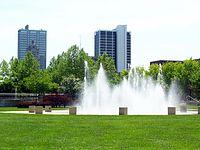
Fort Wayne's first park (and smallest), the 0.2 acre (800 m ²) Old Fort Park, was established in 1863. The newest developed park includes Buckner Park, established in 2004. Franke Park is Fort Wayne's most extensive park, at 316.4 acres (1.3 km2), also the home of the Fort Wayne Children's Zoo (ranked fifth best zoo in the nation by Parents magazine in 2009). Downtown Fort Wayne is home to the Foellinger-Freimann Botanical Conservatory and the 20,000-square-foot (1,900 m2) Lawton Skatepark. As of 2007, Fort Wayne Parks and Recreation maintained 84 parks and dozens of smaller community parks and playgrounds, covering 2,805 acres (11 km2). Allen County Parks include Cook's Landing County Park, Fox Island County Park, Metea County Park, and Payton County Park, all four of which cover nearly 900 acres (3.6 km2). Northeast of Fort Wayne, near Grabill, is Hurshtown Reservoir, the largest body of water in Allen County, at 240 acres (1.0 km2).
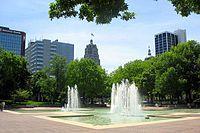
Fort Wayne is also making efforts in restoring natural wetlands to the region. In southwest Allen County, the Little River Wetlands Project's Eagle Marsh contains 705 acres (285.30 ha) of protected wetlands, making it one of the largest wetland restorations in the state of Indiana. Nearby Arrowhead Marsh is also in the process of restoration. Many species of turtles, herons, and cranes have been reported of making a resurgence in the wetlands.
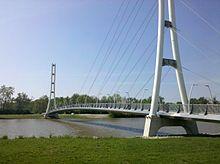
In recent decades, Fort Wayne has developed new paths and paved walking trails along the riverbanks, known as the Rivergreenway, not only to beautify the riverfronts, but to also promote healthier living habits for residents around the community. As of 2011, the Rivergreenway and additional trails now encompass 66 miles (106 km) throughout the city and county. The Rivergreenway was designated as a National Recreation Trail in 2009.
It was announced November 2007, that the Indiana Department of Transportation (INDOT) had awarded the City of Fort Wayne nearly $1 million to aid in construction that will soon begin on a new extension of the Fort Wayne Trail Network, called the Pufferbelly Trail, that will eventually link the Fort Wayne Children's Zoo in Franke Park and the northern suburbs of Fort Wayne with the rest of the trail system. The final plan includes joining Pokagon State Park near Angola, Indiana in the north, and Ouabache State Park in the south near Bluffton, Indiana.[100]
In the spring of 2008, ABC affiliate WPTA-TV received $10,000 in seed money from the reality television series Oprah's Big Give which was then received by Aboite New Trails, Fort Wayne Trails, Greenway Consortium, and Northwest Allen Trails, four organizations in Fort Wayne. The donations topped $1 million April 12, 2008 at a community celebration named Oprah's Big Give: Fort Wayne Trails in Headwaters Park with Indianapolis Colts Coach Tony Dungy and players in attendance.[101] On April 21, 2008, Fort Wayne was featured on a segment of The Oprah Winfrey Show in recognition for raising the most money of the ninety participating cities in the country. The final total rounded-out to $1.2 million.[102]
In March 2009, Mayor Tom Henry announced plans for the placement of three bicycle lanes on streets throughout the city in response to a survey conducted in the fall of 2008 in which thousands answered regarding the need for such lanes in the community.[103]
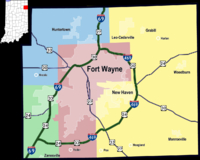
Fort Wayne is home to Indiana University aePurdue University Fort Wayne (IPFW), with an enrollment of 14,190, it is the fifth-largest public university in Indiana. The city also holds the main campus of the Northeast Region of Ivy Tech Community College, the second-largest public community college campus in Indiana. Indiana University maintains the third public higher educational facility in the city with the Fort Wayne Center for Medical Education, a branch of the Indiana University School of Medicine.
Religious-affiliated schools in the city include the University of Saint Francis (Roman Catholic), Concordia Theological Seminary (Lutheran), and Indiana Wesleyan University (Wesleyan Church). Business and technical schools include Indiana Institute of Technology (IIT) as well as regional branches of Brown Mackie College, Harrison College, International Business College, ITT Technical Institute, Manchester University College of Pharmacy, MedTech College, and Trine University.
Four separate districts offer public education in the city. These include East Allen County Schools, Fort Wayne Community Schools, Northwest Allen County Schools, and Southwest Allen County Schools. Fort Wayne Community Schools is the second largest public school district in Indiana, enrolling 31,022 students as of the 2011-2012 academic year.[104] Private education is offered largely through Lutheran Schools of Indiana, which operates 15 schools within Allen County and the Roman Catholic Diocese of Fort Wayne-South Bend, which operates 15 schools within the county. Blackhawk Christian School and Canterbury School also offer private K-12 education in Fort Wayne. Amish Parochial Schools of Indiana has schools through eighth grade in rural eastern Allen County.[105]
Fort Wayne and Allen County residents have been served by the Allen County Public Library (ACPL) and its 14 branches since its founding in 1895 as the Fort Wayne Public Library. The entire library system began an $84.1 million overhaul of its branches in 2002, finishing work by 2007.[106] The centerpiece, the Main Library Branch, now covers 367,000 square feet (34,100 m2), featuring an art gallery, underground parking garage, bookstore, cafe, and community auditorium.[107] According to 2009 data, over 7.4 million materials were borrowed by patrons, and over 3 million visits were made throughout the library system.[108] The Fred J. Reynolds Historical Genealogy Department, located in the Main Library Branch, is the largest public genealogy department in the United States, home to more than 350,000 printed volumes and 513,000 items of microfilm and microfiche.[109][110]
In 1997, Places Rated Almanac recognized Fort Wayne as having the highest reading quotient of any place in North America, due in part to the city's quality library system.[111]
Fort Wayne International Airport is the state's third-busiest airport behind Indianapolis International Airport and South Bend Regional Airport, serving almost 650,000 passengers in 2010.[112] Fort Wayne International shares the distinction with O'Hare International Airport and Detroit Metropolitan Wayne County Airport as one of three Midwest commercial airports containing a 12,000-foot (3,700 m) runway.[112] Fort Wayne International is also homebase for the 122d Fighter Wing of the Indiana Air National Guard.[113] Smith Field, in northern Fort Wayne, is used primarily for small aircraft and pilot education and training.[114]

Until November 10, 1990, Fort Wayne was served by Amtrak's Broadway Limited (Chicago aePittsburgh aeNew York). Conrail's proposed abandonment of a line between Gary, Indiana and Valparaiso, Indiana forced Amtrak to re-route the train further north through Nappanee, Indiana.[115] Amtrak's nearest station to Fort Wayne is in Waterloo, located some 25 miles (40 km) to the north. Thruway Motorcoach, a dedicated bus service between Fort Wayne and Waterloo, ended in 1994.[116] Recently, there has been momentum to bring passenger rail service back to the city in the form of Amtrak or other high-speed rail service.[117]
Freight service is provided by Norfolk Southern, which has two major routes that cross the city. Norfolk Southern also maintains a switching yard, service, maintenance and dispatching operation in nearby New Haven. The Chicago, Fort Wayne and Eastern Railroad, a part of RailAmerica, also serves Fort Wayne via a lease of CSX Transportation's former Pennsylvania Railroad line. Fort Wayne is also the headquarters and the main operations hub of Norfolk Southern's Triple Crown Services subsidiary, the nation's largest user of roadrailer equipment. Triple Crown's terminal is located in the former Pennsylvania Railroad Piqua Yard southeast of downtown.
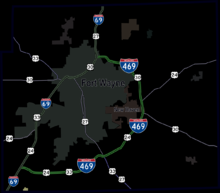
Fort Wayne is served by a single Interstate (Interstate 69) along with an auxiliary beltway (Interstate 469, Ronald Reagan Expressway). I-69 runs south, terminating at Interstate 465 in Indianapolis and north, terminating at the Canadian border at Port Huron, Michigan.
Unlike most cities comparable to its size, Fort Wayne lacks a freeway system through the heart of the city. In 1947, Fort Wayne residents voted down a referendum that would have allowed for the construction of a $27 million, federally-funded freeway, dubbed the Anthony Wayne Parkway.[118] In response to the Federal Aid Highway Act of 1956, I-69 was constructed along the western and northern fringes of Fort Wayne. The largest public works project in Allen County history ($207 million), the I-469 beltway around the southern and eastern fringes of Fort Wayne and New Haven was constructed between 1988 and 1995.[118] Completion of I-469 rerouted most of the federal and state highways around the city instead of through, alleviating traffic on neighborhood thoroughfares.
Four U.S. Routes intersect through the city, including U.S. 24, U.S. 27, U.S. 30, and U.S. 33. U.S. 24 is currently being reconstructed east of the city and upgraded as a four lane divided highway with interchanges. This is part of the larger U.S. 24 project known as "Fort to Port" (Fort Wayne to Toledo). Five Indiana State Roads also intersect the city, including State Road 1, State Road 3, State Road 14, State Road 37, State Road 930. An extension of Airport Expressway, a four lane divided highway, was opened in 2001 directly linking Fort Wayne International Airport with I-69 at a cost of $9.8 million.[119]
Fort Wayne's mass transit system is managed by the Fort Wayne Public Transportation Corporation. Citilink provides bus service via twelve routes through the cities of Fort Wayne and New Haven.[120] CampusLink, which debuted in 2009, is a free shuttle service for students, faculty, and the general public to travel between Ivy Tech's Coliseum and North campuses, IPFW and its student housing on the Waterfield Campus, and shopping and residential areas.[121] The system's annual ridership is 2.2 million.[121]
Fort Wayne is served by two intercity bus providers: Greyhound Lines (Indianapolis aeToledo aeDetroit) and Lakefront Lines (Chicago aeColumbus aeAkron).[122]
Fort Wayne is served by six hospitals; Dupont Hospital, Lutheran Hospital of Indiana, Parkview Regional Medical Center, Parkview Hospital Randallia, Rehabilitation Hospital of Fort Wayne, and St. Joseph Hospital, encompassing over 1,300 patient beds. These six hospitals belong to either of the two health networks serving the region: Parkview Health System or Lutheran Health Network.
Electricity is provided to Fort Wayne residents by Indiana Michigan Power.[123] Northern Indiana Public Service Company provides residents with natural gas.[123] The City of Fort Wayne supplies residents with 72 million US gallons (270,000 m3) of water per day via the Three Rivers Water Filtration Plant and Saint Joseph River.[124] Hurshtown Reservoir, in northeast Allen County, contains 1.8 billion US gallons (6,800,000 m3) of water to be rationed in the event of a major drought or disaster at the three rivers.[125] The City of Fort Wayne also provides residents with sewage treatment and offers a full waste collection service.[123]

Word Count: 6369






